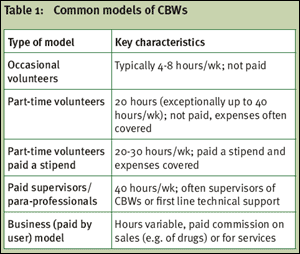
|
One of the major problems in Africa is that services provided by government often do not reach communities, especially rural communities (eg see Khanya, 2001). One way of addressing this is via community-based workers (CBWs) such as community animal health workers, homebased carers, peer educators etc. Lessons from Uganda, South Africa, Lesotho and Kenya suggest that these models can be applied at large scale and can have a major impact on livelihoods. These lessons are drawn from several sectors including natural resources. To scale up such approaches successfully requires rethinking service provision, and a major investment in the capacity of civil society. Methodologies for scaling up need to be developed including standardisation of training and allowances, large-scale capacity-building of civil society to take forward such approaches, as well as coordination and management of potentially numerous CBWs in communities. Government will need to mainstream
funding such approaches, seeing them as front-line service delivery and so a priority rather than the last to be funded. Resistance from some professionals needs to be addressed for this to succeed, with clarity that improved front line delivery will result in increased demand for value-added professional services.
Policy conclusions
-
There is significant evidence that CBW systems have improved the quality of life of their clients. This evidence is strongest in the health sector although qualitative evidence suggests this to be true in the NR sector as well, eg with community animal health workers (CAHWs);
-
These models, although using ‘alternative’ providers (the CBWs), are often well integrated with government systems;
-
Like-for-like, the systems appear to cost around one-third that of conventional services;
-
Therefore community-based and para-professional services offer the opportunity of devolving aspects of services to those who can be trained more cheaply and quickly and are paid less, so that, within a given budget, their numbers can be increased;
-
If the model is to be applied widely, national governments need to develop policy and legislation to support the development and scaling up of this method of service delivery;
-
Up-scaling will require greater standardisation of training outcomes, standards of delivery, conditions of service and remuneration;
-
Funding at scale will have to come from government, possibly with support from external funders. The costs of paying the CBWs could be offset to some extent by savings elsewhere eg in reduced hospital admissions. In a wider vein, benefit:cost ratios are expected to increase as livelihoods improve;
-
These cadres need to be recognised in law, eg CAHWs;
-
A system needs to be created for coordination and management of what could be numerous CBWs of different types in the same community, and for capacity-building of civil society;
-
If they are to be widespread, a representative body and specific legislation is needed to regulate and advocate for CBWs within their different spheres of work so that they know their rights and responsibilities and are protected from exploitation.
Introduction
Community-based services offer the potential to reach many more people within the limited financial resources available to African governments, to respond to widespread need as in the situation of HIV and AIDS, and to significantly improve people’s quality of life. In addition, they allow communities to influence services to meet their own, locallyspecific needs, and to monitor the performance of delivery agents.
CBWs are essentially volunteers, selected from the community in which they live, trained to render a specific task, supported and supervised by a facilitating agent (FA) which may be either a nongovernmental organisation (NGO) or government entity, and often supported by technical service providers (see Figure 1). The CBW may play some of the following roles:
-
acting as a conduit for information and technologies (and sometimes inputs);
-
being a bridge/link person between the community and service providers/facilitating agent;
-
mobilising the community into groups for learning activities;
-
providing advice and training for community members and providing follow-up support;
-
working on their own activities and providing demonstrations from their own farm or household;
-
animating the community by providing energy and enthusiasm for development activities and maintaining the momentum to pursue them.
Action research conducted by Khanya and its partners in Kenya, Lesotho, South Africa and Uganda has been investigating how community-based worker (CBW) systems can be used to widen access to services and empower communities in the process. This NRP summarises some of the learning from this action research project funded by DFID.


|
|






